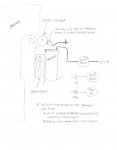My hydraulic steering fittings hit the transom if the motor is tilted too high with the jack plate down. I set up a safety limit circuit but if I wire it the way I would like to, I will wind up with 12 volts + on the aluminum transom cap at all times (except when it is limited out). I run the boat in salt water mostly which I fear makes things worse.
-Will this set up an undesirable electrolysis condition?
-If the salt water washes over the motor and the transom plate, will it make the circuit?
I can wire it differently so voltage is only present when tilting or jacking but will have to use a different relay and latch circuit (more to go wrong). Did a quick drawing if it helps. It is not exactly what I did but it should get the point across.
-Will this set up an undesirable electrolysis condition?
-If the salt water washes over the motor and the transom plate, will it make the circuit?
I can wire it differently so voltage is only present when tilting or jacking but will have to use a different relay and latch circuit (more to go wrong). Did a quick drawing if it helps. It is not exactly what I did but it should get the point across.





















